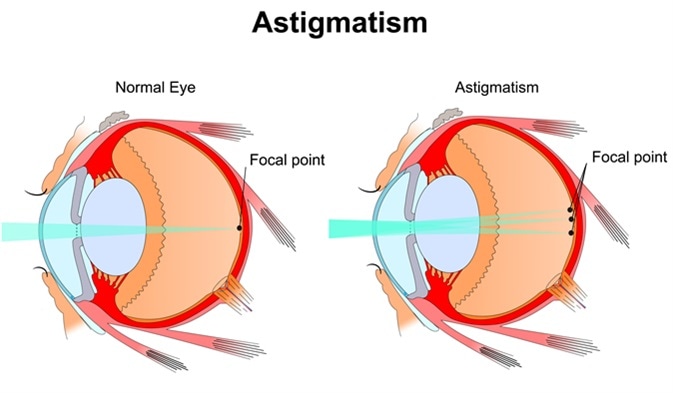Astigmatism is a type of refractive inaccuracy in which the shape of the normally curved surface of the cornea is curved to different degrees in different areas.
As a result of this abnormality, the light rays that enter the eye fails to converge at a focal point and instead comes to a focus at different focal points with a distance between them. This produces out-of-focus vision and the image formed on the retina is blurred.
A person with astigmatism may perceive a clear image at one angle while attempting to focus on another point.

Image Credit: SG SHOT / Shutterstock
This abnormality can either exist from birth or may develop as the child grows. Injuries or certain eye diseases can also cause astigmatism. Both children and adults may be affected by this.

Astigmatism. Eye vision disorder. Diagram of the eye. Image Credit: Slave SPB / Shutterstock
Diagnosis of Astigmatism
A complete eye examination is required to diagnose astigmatism. Different methods may be used, as follows:
- Visual Acuity: The three visual acuity tests are distance vision, near visions, and Amsler grid test. In the Amsler grid tests, all straight lines should be seen as unbroken with no distorted or omitted areas. In the distance and near vision tests, all letters should be read accurately on the line 20/20. In the distance vision test, the patient is not able to read the lines at 20/20. Astigmatism may be one of the causes.
- Refraction test: Patients are requested to look through a special refractor device called the phoropter and read the eye chart. The resulting measured vision level by this test is known as BCVA—“Best Corrected Visual Acuity.” Abnormal results can be caused by astigmatism, hyperopia, myopia, or presbyopia. When the patient response is inaccurate or unobtainable, optometrists choose to perform retinoscopy to measure the refraction levels.
- Keratometry: Keratometry classifies dissimilar corneal curves by using two divided meridians. Irregular astigmatism results in distorted keratometry. A keratometer is used to measure the corneal curvature. A light is focused over the cornea and the reflection is measured—both angle and cylindrical power. This measurement helps to calculate the curvature surface area of the cornea so as to arrive at the right decision as to the proper contact lenses to be prescribed to correct astigmatism is taken.
- Corneal topography: Corneal topography is a vital tool in recognizing the shape and curve of the cornea.
- Astigmatic fan diagram test: In the fan diagram test the lines are drawn from a black center point. The fan lines are of the same width and darkness. When a patient sees the diagram and if some of the lines in the fan diagram appear specifically darker and appear sharper, it is likely that the patient may have astigmatism.
- Jackson cross-cylinder test: This test is used to do the final corrections of the axis of astigmatism. With modern techniques, this test may be outdated but this is one of the most accurate tools to understand the theories of refraction.
Treatment of Astigmatism
Mild or restricted astigmatism does not require correction. The use of glasses and contact lenses may reduce but cannot cure astigmatism. With time, the condition may change and the requirement for new glasses or contact lenses may arise. Surgical correction is the only procedure that can almost eliminate or reduce astigmatism to a great extent.
The various treatment procedures available include:
- Optical Therapy: The simplest way to correct astigmatism is with eyeglasses. Contact lenses may also be used in place of eyeglasses. The artificial glasses act as the first refractive area where the light rays that will enter the eye can be focused to the appropriate extent to produce the best focus at the intraocular lens and results in accurate refraction. Contact lenses normally provide a better and broader field and quality of vision. It provides better comfort to many users too.
- Surgical Therapy: When there is a need for significant correction to cure astigmatism, different surgical methods may be used such as:
- LASIK surgery: LASIK surgery is performed to flatten the steepest corneal meridian and to steepen the flattest meridian. It combines two technologies of refractive correction by using a microkeratome to create a slim tissue flap, and excimer laser ablation to restructure the stromal tissue below the flap.
- Astigmatic keratotomy: this refers to the use of surgical incisions on the cornea to produce carefully planned surgical scars that can correct astigmatism after LASIK.
- Phototherapeutic Keratotomy: PTK is the method in which the decomposition of epithelium cells is achieved using phototherapeutic techniques. Thin layers are removed microscopically, thus correcting the corneal irregularities.
- Laser thermal keratoplasty: Holmium YAG laser is used with a slit-lamp system is used to create spots in the perimeter of the peripheral cornea in this method.
- Conventional refractive surgery: Optical rectification surgeries use excimer laser photoablation to cure astigmatism. This alters the corneal shape and rectifies the error in refractive function of the cornea.
References
- https://www.healthdirect.gov.au/astigmatism
- https://www.aoa.org/patients-and-public/eye-and-vision-problems/glossary-of-eye-and-vision-conditions/astigmatism?sso=y
- https://medlineplus.gov/ency/article/003446.htm
- https://medlineplus.gov/ency/article/003844.htm
- http://hyperphysics.phy-astr.gsu.edu/hbase/vision/astigtest.html
- https://aapos.org/home
- http://eyewiki.aao.org/Cross-cylinder_technique_for_subjective_refraction
- https://wwwn.cdc.gov/nchs/data/nhanes/2007-2008/manuals/manual_vi.pdf
- https://medlineplus.gov/ency/article/001015.htm
- https://www.ncbi.nlm.nih.gov/
- https://www.aoa.org/patients-and-public/caring-for-your-vision/corneal-modifications/refractive-surgery-and-corneal-modification-definitions?sso=y
- https://www.floridahealthfinder.gov/healthencyclopedia/Health%20Illustrated%20Encyclopedia/1/001015.aspx
Further Reading
Last Updated: Aug 21, 2023